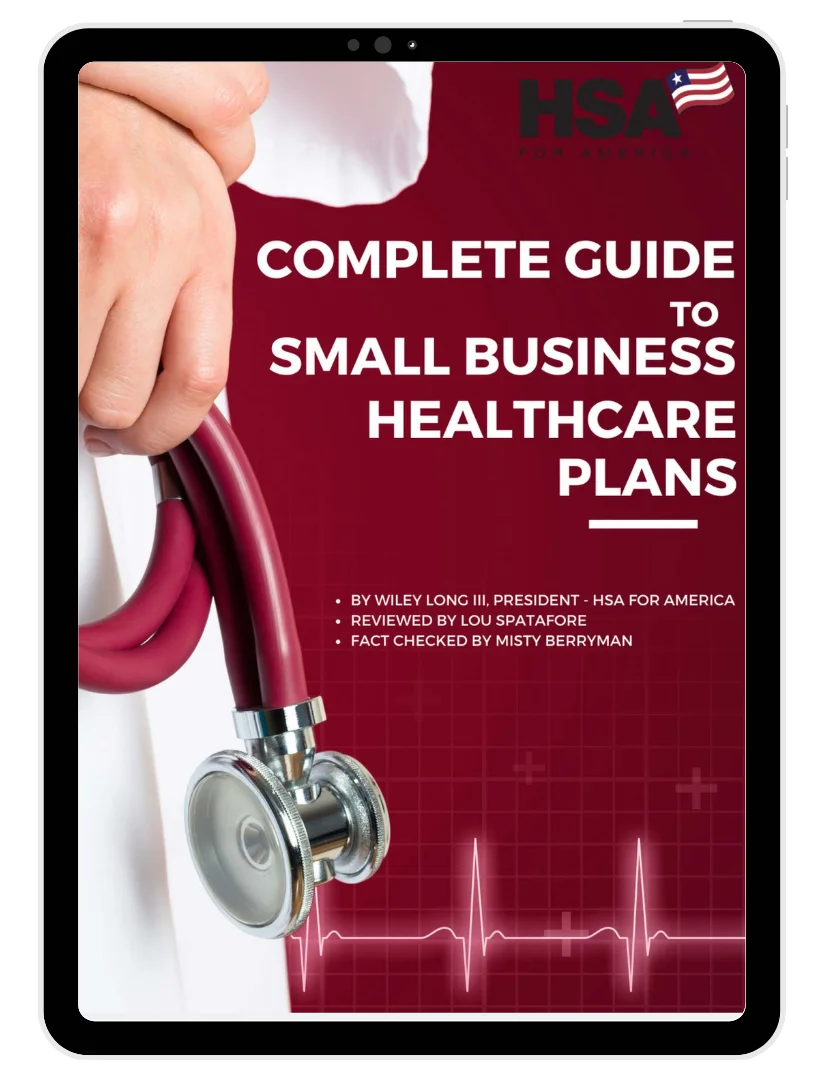2026 Guide to Small Business Healthcare Plans
Everything you need to know about creating an affordable small business health plan for companies with fewer than 50 employees – including HRAs, health sharing plans, HSAs, insured plans, and Direct Primary Care plans.

By Wiley Long III, President – HSA for America
Reviewed by Lou Spatafore
Fact checked by Misty Berryman – Updated 9/3/2025
Request a Group Quote for Your Company
How to Choose the Best Healthcare Plan for Your Small Business
Choosing a small business health insurance option for your employees can seem like a daunting task. Before you begin, ask yourself the following questions:
What options is your company eligible to offer?
How much are you willing to spend on small business health benefits?
How much time do you have to manage and administer benefits?
Which benefit options would be of highest value to your employees?
Four Steps to Getting Healthcare Plans for Your Small Business
If you’re looking for the best healthcare options for small businesses with 2 to 49 employees, this step-by-step primer breaks everything down into easy-to-understand terms.
Step One: Review Your Budget
Many small business owners forgo business health insurance plans because of the high price. But there are some options like HRAs and health sharing plans that fit even the smallest company’s budget.
The first thing you need to determine is how much you are willing to contribute for SMB healthcare.
Step Two: Consider your Employee’s Annual Income
The amount of money your employees are currently making may affect the affordability of their healthcare. For example, some HRAs are not compatible with the Affordable Care Act (ACA) subsidy, which could force your employees to have to choose one or the other.
Knowing your team’s income levels can help you find a small business health care solution that supports both compliance and cost-efficiency.
Step Three: Consider Your Employee’s Coverage Needs
It’s always a good idea to talk to your employees about their health needs before purchasing a plan. Try to get a feel for how often they use their coverage, and whether or not the benefit you’re thinking about would help them pay for their healthcare and qualifying medical expenses.
Step Four: Talk to Your Personal Advisor About Small Group Insurance
Unlike traditional insurance, group health plans for small businesses do not need to be “one-size-fits-all”. With HRAs, HSAs, and healthcare for small businesses, it’s possible to create a flexible benefits package that encourages employees to take ownership of their health decisions.
In addition, it’s possible to build different combinations of these benefits for added convenience. For example, pairing a health-sharing plan with an employee’s HSA is a great way to offer balanced SMB healthcare coverage without spending too much.
A well-designed group plan can also make your company more attractive to new hires, while helping you retain top talent in a competitive market.
Request a Group Quote for Your Company

Complete Guide to Small Business Healthcare Plans
Free PDF Download
Explore this step-by-step report backed by the knowledge and experience of our in-house small business healthcare experts.
Small Business Healthcare Plan Options
These are the five strategies we most often recommend to our small business clients.
Option One: Employees Obtain Their Own Coverage
If your business has fewer than 50 employees, then you are not required to offer healthcare plans. But, as many small business owners can tell you, growing without small business health benefits is tough.
On the other hand, sometimes the smarter financial move is to not offer health benefits. For example, some low-income employees might qualify for an ACA subsidy on the individual market, making it the cheaper option. Or, perhaps some of your employees are already covered by a spouse’s group plan.
As you’ll find out in this guide, health insurance for small businesses is more affordable than you think. It also provides valuable health care tax credit opportunities for employers and employees alike.
Pros
✔ It’s easier than choosing and administering a health benefit.
✔ Your employees might already be covered, or eligible for a cheaper plan with an ACA tax credit.
Cons
✘ Offering no health benefits can make it hard to attract new talent.
✘ Wage increases (as opposed to some benefit offers) are taxable to the employee.
Option Two: Small Group Health Insurance
With small group health insurance, the employer chooses a policy plan and then pays a fixed premium for every enrolled employee. The employee pays their share from their paycheck, and is covered as long as they are employed.
It works just like a personal plan, but with more benefits and potential for a health care tax credit up to 50% of your contributions for businesses with fewer than 25 employees.
Some group health plans for small businesses are also HSA-qualified. This means that you can offer an additional tax-free benefit in the form of a health savings account (HSA).
Pros
✔ Employer and employee contributions are both tax-deductible.
✔ Offering health insurance can reduce turnover, increase productivity, and attract new talent to your company.
✔ Businesses with fewer than 25 employees may be eligible for a big health care tax credit worth up to 50% of total plan contributions.
Cons
✘ Wage increases (as opposed to some benefit offers) are taxable to the employee.
Option Three: HRAs for Small Business
Health reimbursement arrangements, or HRAs, are a common benefit option for businesses with fewer than 30 employees. Small business HRAs let employers compensate their workers for their own individual health plans, as a tax-free benefit.
In most cases, reimbursements are used for plan premiums. However, they can also be used for eyeglasses, dental insurance, and other out-of-pocket costs.
HRAs are popular with small companies because they are highly flexible. The employer can choose how much to contribute each month, without having to worry about unexpected fluctuations in cost.
HRAs are popular with employees because they allow the individual to choose a plan of their own, as opposed to being pigeonholed into a plan that isn’t a good fit.
Pros
✔ Employers choose how much to contribute (there are no contribution minimums)
✔ Employers can set the rules of their own HRA, making them very flexible
✔ Employees get to choose their own plan, and take it with them if they are no longer employed with the company
Cons
✘ HRAs require the employee to have their own individual coverage
✘ Most HRAs are incompatible with the ACA subsidy, meaning some employees may have to choose between the two
Option Four: Health Sharing Plans for Employees
Health sharing for small businesses is an affordable alternative to traditional insured plans. Members share costs via a reimbursement model.
Health care sharing is not actually health insurance at all. Instead, it is a membership-based cost-sharing program. In exchange for a monthly contribution, members can have their medical expenses shared according to a fixed-price reimbursement model.
But like any health care strategy, health sharing isn’t for everyone. These plans come with waiting periods for pre-existing conditions, and coverage is usually less comprehensive.
Pros
✔ Health sharing is one of the most affordable benefit options available
✔ Health sharing is a unique benefit opportunity only available to small employers
Cons
✘ Health sharing is not ideal for individuals with significant medical needs
✘ Health sharing contributions are not tax-deductible
Option Five: Direct Primary Care
Direct Primary Care, or DPC, is an alternative healthcare model where patients or their employers pay a flat monthly or annual membership fee in exchange for unrestricted access to a primary care doctor.
When offered as an employee benefit, workers can see their primary care provider as often as needed for preventative care and maintenance of chronic conditions. Their PCP can refer them to specialists for more advanced care, as needed. There are no co-pays, co-insurance, or other out-of-pocket costs.
DPC works best in conjunction with a high-deductible health insurance plan or health sharing plan, each of which may help with costs for emergency or acute care or specialist care beyond the scope of the PCP’s practice.
Pros
✔ Employees and their families can get more time with doctors
✔ Reduced costs to employers and workers
Cons
✘ DPC plans don’t cover ER visits
✘ DPC does not cover prescription drugs. However, standalone plans are available, or the company HDHP or health sharing plan may assist with drug costs.
Find the perfect Health Care Plan for your medical coverage today with HSA for America.
Need Assistance?
Get Help in Figuring Out the Best Plan for You
Schedule a free appointment with our Personal Benefit Managers. It’s fast, friendly and easy with no obligation.
Ready Now?
Request a Group Quote for Your Company
Read More About Group Health Insurance Options in Your State
Learn More About Group Healthcare Solutions
Available Plans | HSA Info | Healthshare Info | FAQS | Blog | News | About Us | Contact Us | Privacy Policy | Agents Needed

Contact Information:
1001-A E. Harmony Rd #519 Fort Collins, CO 80525
800-913-0172
info@HSAforAmerica.com
Disclaimer: All information on this website is relayed to the best of the Company's ability, but does not guarantee accuracy. Information may be out of date. The content provided on this site is intended for informational purposes only and does not guarantee price or coverage. This site is not intended as, and does not constitute, accounting, legal, tax, and/or other professional advice. Determination of the actual price is subject to the Carriers.



